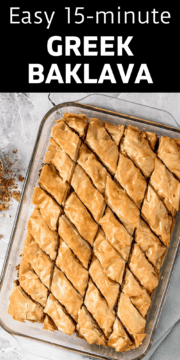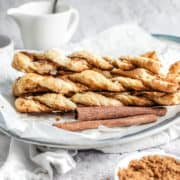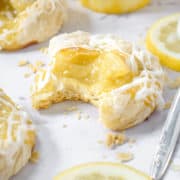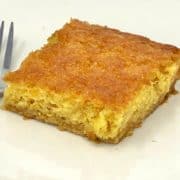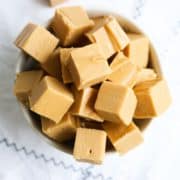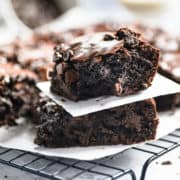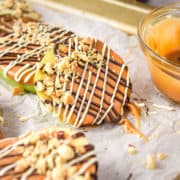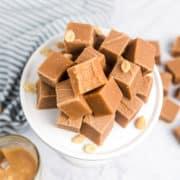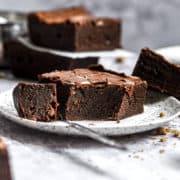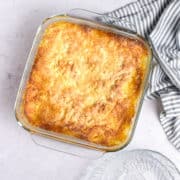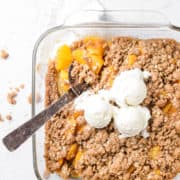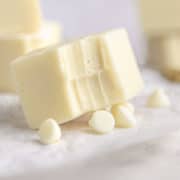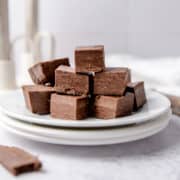I’ve always loved the rich flavors of authentic Greek baklava in its cute little diamond-shaped pieces, but did you know how easy it is to make? This sweet confection made with cinnamon, nuts, lemon, and honey, isn’t hard to make at all, and it is so tasty.
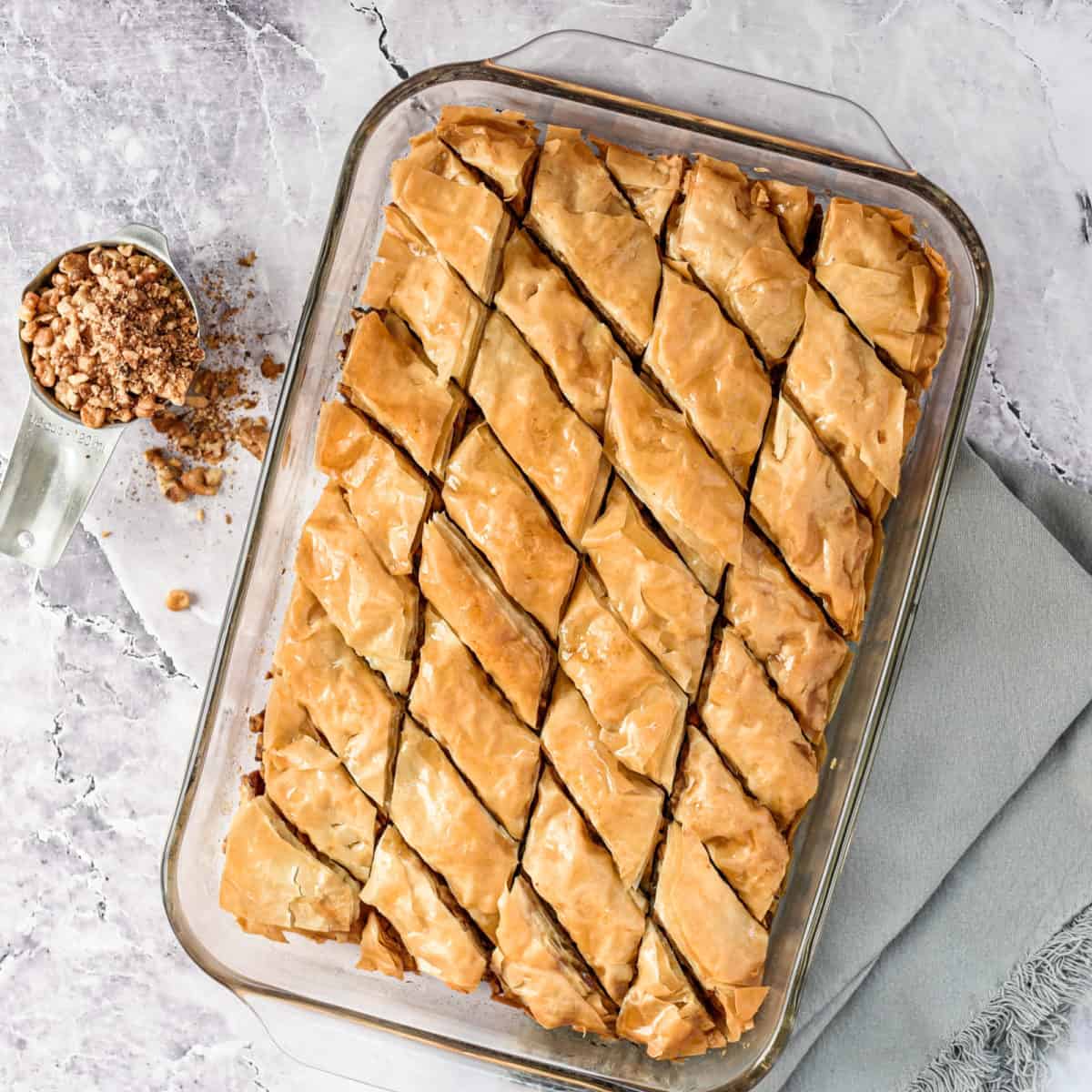
Jump to:
This is an impressive Greek baklava recipe that is perfect for any occasion, so if you’re looking for an alternative to cakes, cupcakes, and other desserts you make frequently, consider this as a change of pace.
Using packaged phyllo dough makes light work of preparing this pastry for the Greek Baklava. Expect the finished Greek baklava to be sweet, sticky, and perfectly delicious! It’s well-loved around the Mediterranean and will certainly be popular at your table.
Some other impressive and surprisingly easy pastries include this cannoli recipe and my delicious savory egg puffs.
Main Ingredients

You might be expecting some complicated ingredients or methods in this Greek baklava but it’s actually far simpler to prepare than you might have expected. Here are the main items you will need to prepare this exquisite treat:
- Phyllo dough: the main component of the recipe. Phyllo dough, which can also be spelled filo dough, is a mostly fat-free dough that is light and flaky. Although you might be wondering whether puff pastry dough is the same, it isn’t, so only use phyllo dough to make baklava.
- Walnuts: for a nutty flavor and crunch. Nuts go beautifully in this baklava recipe. Sometimes I like to use pistachios or a combination of pistachios, walnuts, and hazelnuts, which is more typical of Turkish baklava. You can take your pick according to your preference.
- Cinnamon: for a warm, earthy flavor. Cinnamon complements this sweet and sticky dessert perfectly. You can always sub it for nutmeg if you want a change.
- Honey: for sweetness. Honey offers the perfect amount of sweetness and also gives the baklava its characteristic sticky finish. You can use any honey variety.
- Vanilla: for added flavor. It’s hard to think of a dessert that isn’t improved with a dash of vanilla! It’s certainly good in Greek baklava and complements the other ingredients.
- Lemon juice: to add citrusy tartness. A touch of lemon contrasts nicely with the honey and sugar, balancing out the sweet flavors with a zesty zip.
Instructions Overview
Greek bakers have been making this exquisite Mediterranean dessert for years and now it’s your turn! You need to layer phyllo dough in a greased baking dish, adding nuts and melted butter between each layer.
Cut it into rows diagonally both ways to make diamond shapes. While the Greek baklava is baking in the oven, you can make the glaze.
Water, sugar, vanilla, honey, and lemon combine to make this zesty, sweet, sticky glaze which you can spoon over the baked baklava. Let it cool then enjoy! See how easy that was?
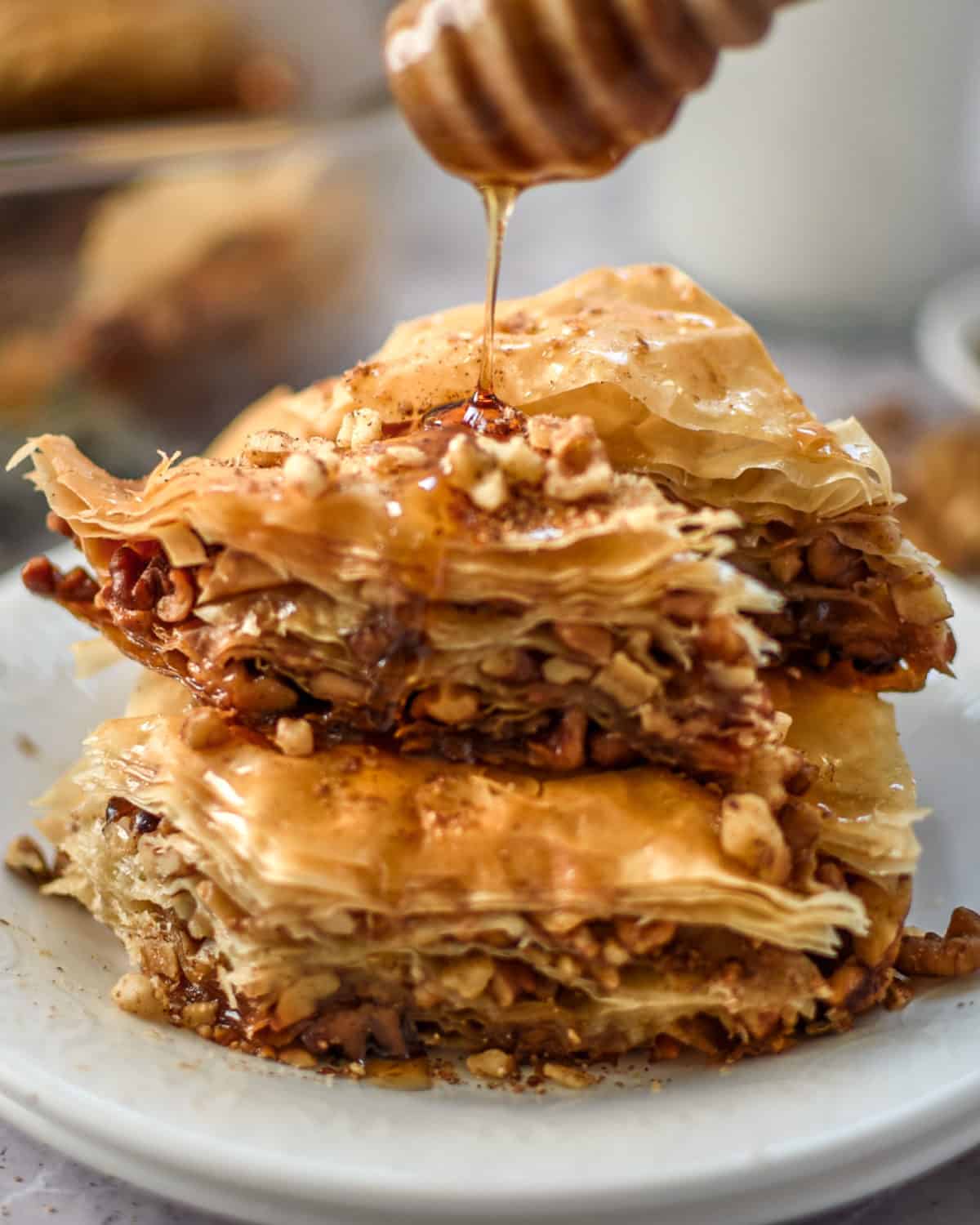
Common Questions
It is believed that this sweet, sticky dessert first appeared during the Ottoman Empire in Turkey and then made its way into Greece, where it was modified. In fact, a lot of countries in the Mediterranean have their own versions of baklava.
Although many people do associate it more with Greece than Turkey, it's not possible to clearly pinpoint the origins of this dessert. These days it's well-loved all over the world.
The answer to this would be not normally. Not only are the layers of dough basted with melted butter but honey is a main ingredient in the recipe and of course that's an animal product. If you do want to try a vegan take on this recipe, use a dairy-free butter alternative and try a vegan honey alternative. It won't taste exactly the same but it will be suitable for vegans if made this way.
It should be hot when poured over the baklava so it soaks into the dessert. So, make the syrup in a pan on the stove and then you can pour it over the Greek baklava as soon as it's done. Another note about the syrup: it needs to be nice and thick or else it will just soak all the way through the baklava and pool underneath it. Don't skimp on the 20-minute simmering time.
It's best to cut the dessert into diamond shapes before it goes in the oven, using a sharp knife. If you cut it after, it will crumble and come apart, so ensure you cut it beforehand. Even if the cuts don’t go all the way through or you miss a bit, that's fine, you can always cut through those parts afterwards.
Wrapped in cheesecloth or a clean tea towel, baklava keeps for up to 2 weeks. It will go soggy if you use plastic wrap. You can keep it on the countertop or in the refrigerator. If it’s refrigerated, it will be a little more chewy and hard which some people actually prefer.
You can definitely make baklava ahead and it keeps for weeks. That only makes the recipe all the more appealing!
As long as it’s wrapped in 2 layers of plastic wrap followed by 2 layers of foil, it will freeze for up to 3 months. Thaw it overnight in the refrigerator.
This rich dessert is best served with coffee after dinner. I have also enjoyed a couple of pieces with a scoop of vanilla or pistachio ice cream alongside.
Well technically you could but baklava is actually best when you drizzle the syrup over the top and then let it sit for a couple of hours. This ensures the syrup soaks through the dessert and softens the layers. So plan it ahead for perfection when it’s time to eat!
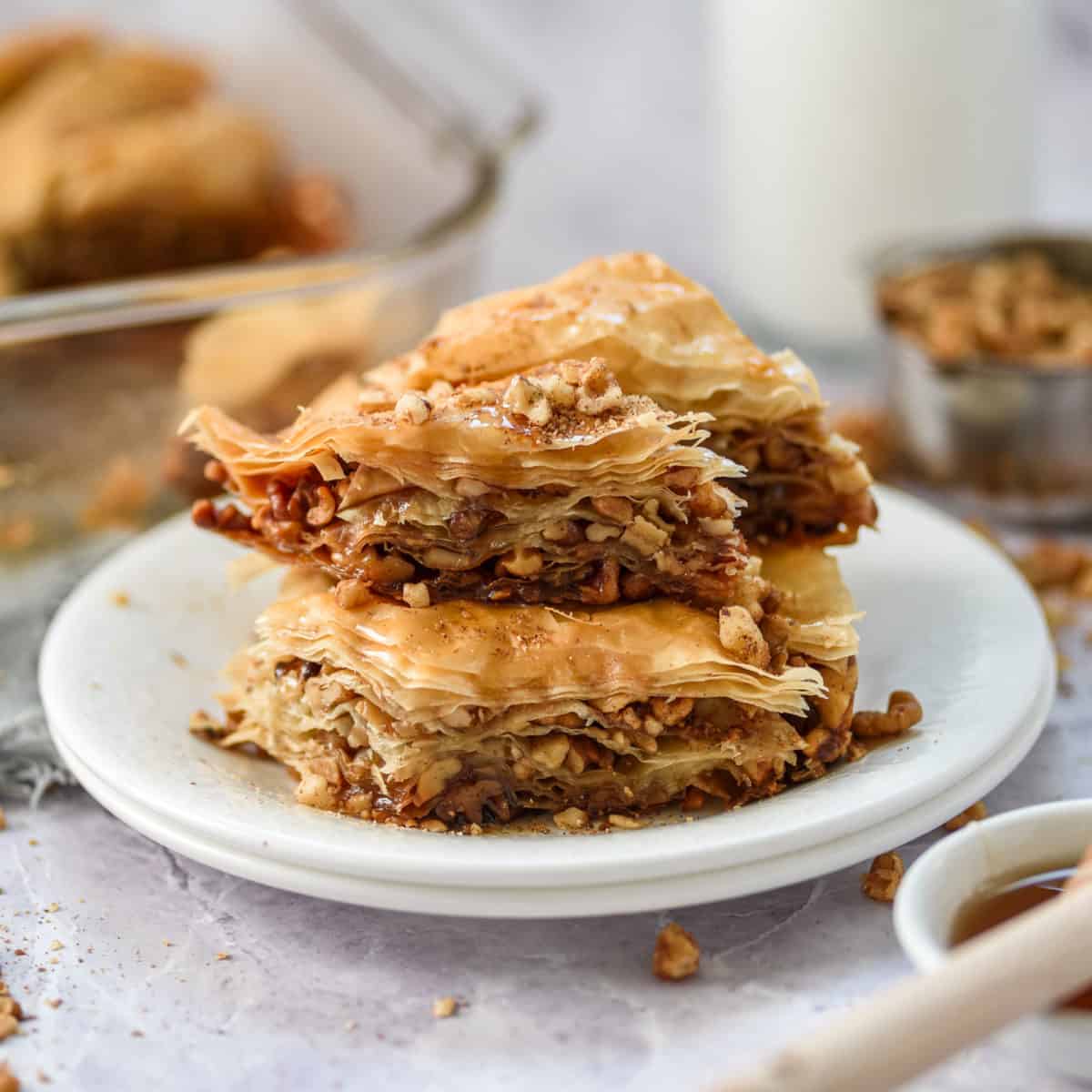
Chopnotch Tips
- Make sure you cut through the dough all the way to the bottom when making the diamond shapes so the pieces come out separately.
- Don’t be stingy with the butter and sugar. Using plenty of these helps to create a rich and indulgent result. It’s supposed to be indulgent since the servings are very small.
- For the best results, drench the baklava in the glaze and let it sit for a couple of hours to absorb it. If you’re worried it might be too sweet, you can use less sugar in the syrup mixture.
- Add a pinch of cardamom for an exciting twist on the flavor.
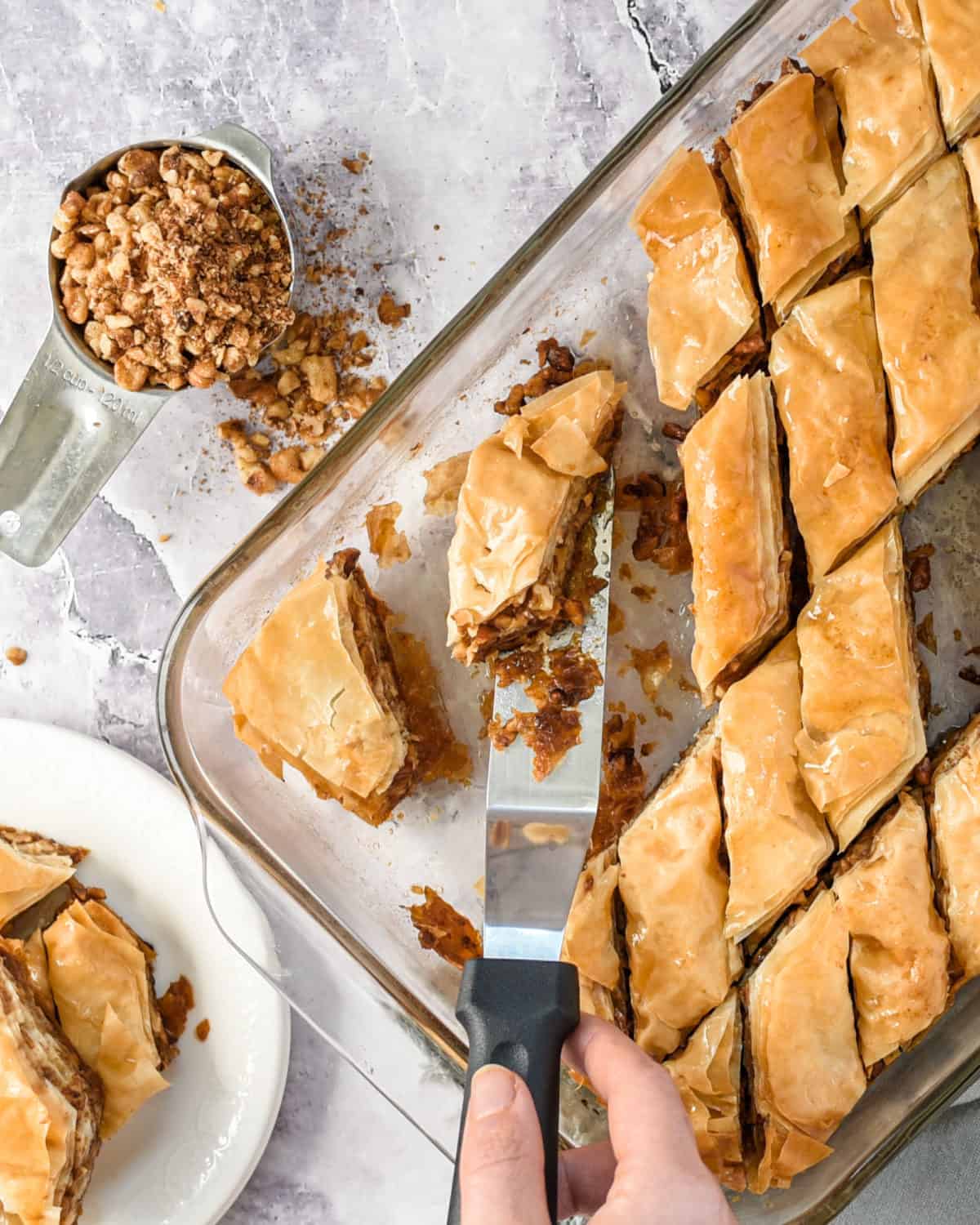
You will love how easy Greek baklava is to make. A little goes a long way with this sticky, sweet Greek dessert and the taste is incredible!
Related Recipes
Let us know what you think! Give this recipe a rating in the comments section below.
Recipe
How to Make
Greek Baklava
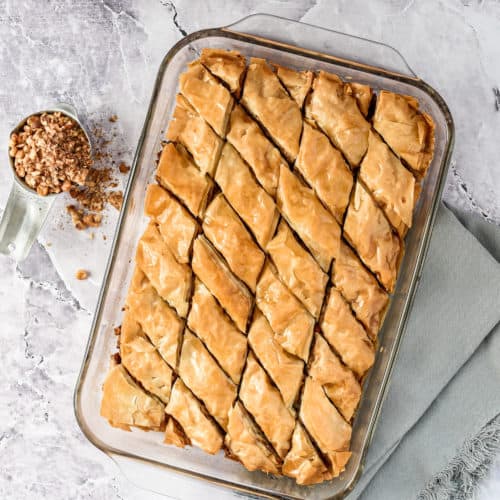
Ingredients
- 16 ounces phyllo dough, (1 package)
- 16 ounces walnuts, chopped
- 1 teaspoon ground cinnamon
- 1 cup unsalted butter, melted
For the syrup:
- 1 cup water
- 1 cup granulated sugar
- 1 teaspoon vanilla extract
- ½ cup honey
- 1 teaspoon lemon juice
Instructions
- Preheat the oven to 350°F. Take a 9x13-inch baking pan and butter the inside of it and then set it aside. Toss the chopped walnuts with the cinnamon and then set aside. Flatten the phyllo dough and cut it in half or trim it so that it fits the baking pan, and then cover it with a damp towel to prevent it from drying out.
- Take two sheets of phyllo and place them into the bottom of the prepared pan and then brush the top of it with plenty of melted butter. Now sprinkle 3 tbsp of chopped nuts on top. Then place another two sheets of phyllo over the nuts and repeat this layering process until all the sheets are used, ending with 6 sheets on top.
- Now cut it into 4 long rows and then make diagonal cuts across the rows to make 36 diamond-shaped pieces being sure to cut all the way down to the bottom of the pan. Then bake it in the preheated oven for about 50 minutes or until golden and crisp on top.
- To make the syrup, boil the water and sugar until the sugar is melted, and then add the vanilla, honey, and lemon juice and let it simmer for 20 minutes.
- With a spoon, pour the syrup over the Baklava as soon as it comes out of the oven. Let cool before serving. Be sure to store uncovered. Enjoy!
Notes
- Make sure you cut through the dough all the way to the bottom when making the diamond shapes so the pieces come out separately.
- Don’t be stingy with the butter and sugar. Using plenty of these helps to create a rich and indulgent result. It’s supposed to be indulgent since the servings are very small.
- For the best results, drench the baklava in the glaze and let it sit for a couple of hours to absorb it. If you’re worried it might be too sweet, you can use less sugar in the syrup mixture.
- Add a pinch of cardamom for an exciting twist on the flavor.
